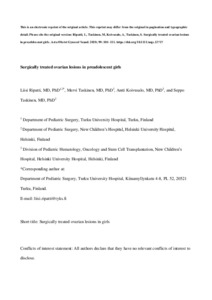Surgically treated ovarian lesions in preadolescent girls
Taskinen M; Ripatti L; Taskinen S; Koivusalo A
Surgically treated ovarian lesions in preadolescent girls
Taskinen M
Ripatti L
Taskinen S
Koivusalo A
WILEY
Julkaisun pysyvä osoite on:
https://urn.fi/URN:NBN:fi-fe2021042822260
https://urn.fi/URN:NBN:fi-fe2021042822260
Tiivistelmä
Introduction The purpose of this study was to investigate the epidemiology and characteristics of surgically treated ovarian lesions in preadolescent girls. Material and methods This was a retrospective cohort study including all 0- to 11-year-old girls operated at a single center from 1999 to 2016 for ovarian cysts, neoplasms or torsions. Patient charts were reviewed for symptoms, preoperative radiological imaging, operative details and histopathology. Results We identified 78 girls, resulting in a population-based incidence of 4.2/100 000. Infants (n = 44) presented with benign cysts (42/44, 95%, one bilateral), a benign neoplasm (1/44, 2%) and a torsion without other pathology (1/44, 2%). Torsion was found in 25/29 (86%) ovaries with complex cysts and in 3/15 (21%) ovaries with simple cysts in preoperative imaging (P < 0.001). Most infants were symptomless. Lesions in 1- to 11-year-old girls (n = 34) included benign neoplasms (n = 21/34, 62%), malignant neoplasms (n = 5/34, 15%), a cyst with torsion (n = 1/34, 3%) and torsions without other pathology (n = 7/34, 21%). Torsion was more common in benign (17/21, 81%) than in malignant neoplasms (1/5, 20%) (P < 0.020). Ovarian diameter did not differ between ovaries with or without torsion (P = 0.238) or between benign and malignant neoplasms (P = 0.293). The duration of symptoms in lesions with or without torsion was similar. Conclusions The majority of surgically treated ovarian lesions in preadolescent are benign lesions with torsion. Surgery should be ovary-preserving and performed without delay.
Kokoelmat
- Rinnakkaistallenteet [19218]
